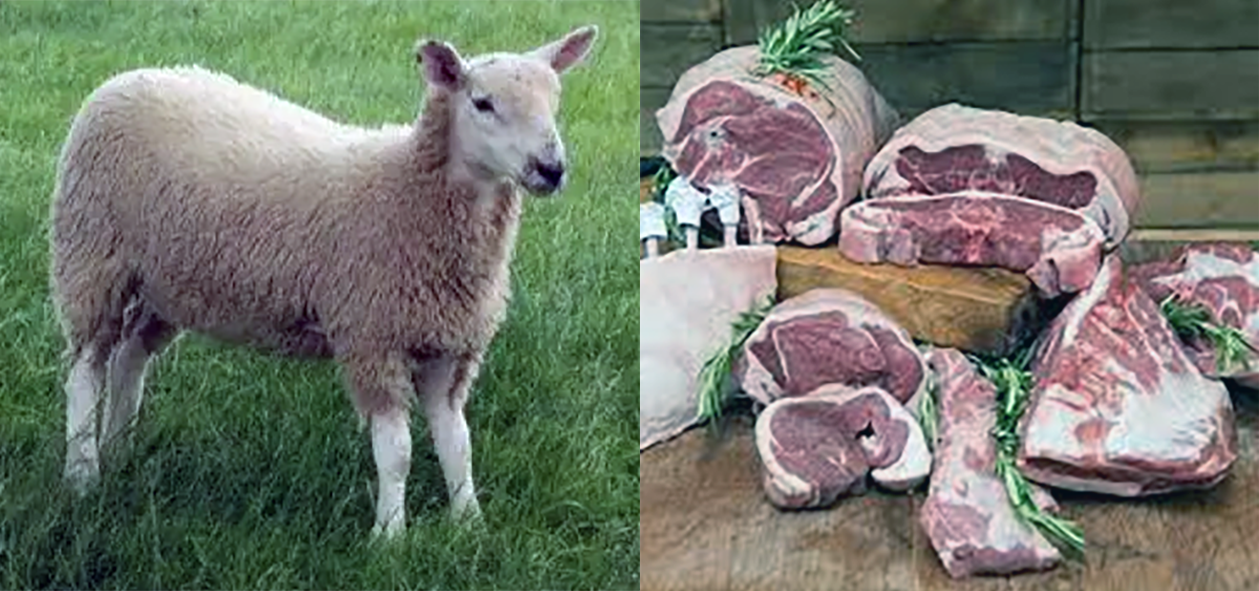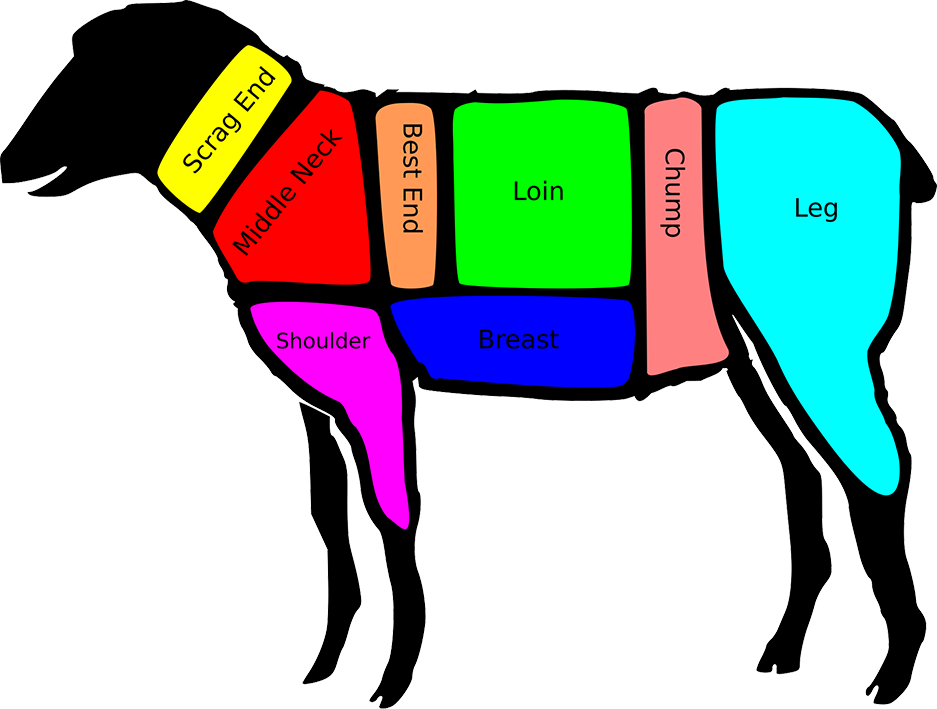FabulousFusionFood's Lamb-based Recipes Home Page
 Mature lamb and a selection of lamb cuts.
Mature lamb and a selection of lamb cuts.
Welcome to FabulousFusionFood's Lamb-based Recipes Page — The recipes presented here are all based on cow meat. Lamb represents a young sheep (Ovis aries) which is less than one year old.
Hogget is term for a sheep of either sex having no more than two permanent incisors in wear, or its meat. In the UK, it means animals that are 11 to 24 months old. Still common in farming usage and among speciality butchers, it is now a rare term in British, Australian and New Zealand supermarkets, where meat of all sheep less than two years old tends to be called 'lamb'.
Other types of lamb are as follows:
Suckling lamb or milk-fed lamb — meat from an unweaned lamb, typically 4–6 weeks old and weighing 5.5–8 kg. This is typically generally unavailable in the UK but can be sourced from speciality butchers and farm shops.
Young lamb — a milk-fed lamb between six and eight weeks old
Spring lamb — a lamb, usually three to five months old, born in late winter or early spring and sold usually before 1 July (in the northern hemisphere).
Yearling lamb — a young sheep between 12 and 24 months old
Salt marsh lamb (also known as 'saltmarsh lamb' or by its French name, agneau de pré-salé) is the meat of sheep which graze on salt marsh in coastal estuaries that are washed by the tides and support a range of salt-tolerant grasses and herbs, such as samphire, sparta grass, sorrel and sea lavender.
The meat of a lamb is taken from the animal between one month and one year old, with a carcass weight of between 5.5 and 30 kg (12 and 66 lb). This meat generally is more tender than that from older sheep and appears more often on tables in some Western countries.
Sheep are most likely descended from the wild mouflon of Europe and Asia, with Iran being a geographic envelope of the domestication centre. One of the earliest animals to be domesticated for agricultural purposes, sheep are raised for fleeces, meat (lamb, hogget or mutton), and milk. A sheep's wool is the most widely used animal fibre, and is usually harvested by shearing. In Commonwealth countries, ovine meat is called lamb when from younger animals and mutton when from older ones; in the United States, meat from both older and younger animals is usually called lamb. Sheep continue to be important for wool and meat today, and are also occasionally raised for pelts, as dairy animals, or as model organisms for science.
Sheep meat and milk were one of the earliest staple proteins consumed by human civilization after the transition from hunting and gathering to agriculture. Sheep meat prepared for food is known as either mutton or lamb, and approximately 540 million sheep are slaughtered each year for meat worldwide. "Mutton" is derived from the Old French moton, which was the word for sheep used by the Anglo-Norman rulers of much of the British Isles in the Middle Ages. This became the name for sheep meat in English, while the Old English word sceap was kept for the live animal. Throughout modern history, "mutton" has been limited to the meat of mature sheep usually at least two years of age; "lamb" is used for that of immature sheep less than a year.
Cuts of Lamb (UK, Canada, and other Commonwealth countries):
 Cuts of Lamb:
Cuts of Lamb:Scrag end (of neck) — stewing
Middle neck — braising, stewing
Best End (of neck) — roasting, stewing, braising
Loin (including chops, racks and saddle) — roasting, frying, braising
Chump (and chump chops) — frying
Barnsley chop, a large double loin chop — frying
Leg (gigot in Scotland) including leg steaks — roasting, frying
Shank — braising
Shoulder — roasting Breast — braising
Offal — typically tongue, liver, heart, stomach, sweetbreads, testicles, intestines and kidneys
The alphabetical list of all the lamb-based recipes on this site follows, (limited to 100 recipes per page). There are 507 recipes in total:
Page 1 of 6
| Ćevapčići Origin: Serbia | Arvi aur Gosht ka Khatta Salan (Taro and Lamb in a Tangy Sauce) Origin: India | Braised Greek-style Lamb Chops Origin: Fusion |
| Ćevapi Origin: Bosnia | Asharbal Leebia (Libyan Soup 2) Origin: Libya | Braised Lamb Shanks with Cannellini Beans Origin: Britain |
| Aaloo Gosht (Mutton Curry with Potatoes) Origin: Pakistan | Baamiye Suqaar (Meat and Okra Stew) Origin: Somalia | Brik Dannouni (Stuffed Lamb Turnovers) Origin: Tunisia |
| Abbacchio alla Cacciatora Origin: Italy | Bak Kut Teh (Spicy Sparerib Soup) Origin: Malaysia | Brunei Murtabak (Meat Rotis) Origin: Brunei |
| Abbachio al Forno (Italian Roast Baby Lamb) Origin: Italy | Baked Haggis with Whisky Cumberland Sauce Origin: Scotland | Brunei Murtabak (Meat Rotis) Origin: Singapore |
| Adana Kebab Origin: Turkey | Baked Lamb with Potatoes and Artichokes Origin: Ireland | Brunei Satay Origin: Brunei |
| Adana Kebap Origin: Turkey | Balti Tandoori Keema Origin: Britain | Butterflied Lamb Shoulder with Salsa Verde Origin: Britain |
| Adobo Valentine Lamb Origin: American | Bamieh (Okra Stew) Origin: Iraq | Butterfly Chops with Redcurrant Glaze Origin: Britain |
| Afghan Kofta Curry Origin: Afghanistan | Bangladeshi Vindaloo Origin: Britain | Butterfly Lamb with Balsamic Vinegar and Mint Origin: British |
| Agneau au Cari (Lamb Curry) Origin: Reunion | Barbecue Baharat Lamb Chops with Vegetable Salad Origin: Australia | Byrger cig oen a bara lawr gydag awch iogwrt â mintys (Lamb and Laverbread Burger with Yoghurt and Mint Relish) Origin: Welsh |
| Agneau Provençal au Jus Menthe Verte (Roast Lamb Provençal with Mint Gravy) Origin: France | Barbecued Kibbeh Origin: African Fusion | Byrgers Rwdan, Rhosmari ac Oen (Swede, Lamb and Rosemary Burgers) Origin: Welsh |
| Agnum Simplicem (Plain Lamb) Origin: Roman | Barbecued Lamb Ribs Origin: Britain | Cafréal de Cordeiro (Lamb Cafréal) Origin: Angola |
| Air Fryer Lamb Chops Origin: Britain | Barbecued Spice-crusted Lamb Origin: Britain | Cape Malay Mutton and Dhal Curry Origin: South Africa |
| Air Fryer Lamb Koftas Origin: Britain | Barley Kail Origin: Scotland | Cape Malay Mutton Curry Origin: South Africa |
| Air Fryer Liver and Sausage Curry Origin: Britain | Bengali Hot Dry Meat Curry Origin: India | Cape Malay Spicy Lamb Chops Origin: South Africa |
| Air Fryer Pancakes Origin: Britain | Bhindi Gosht (Pakistani Mutton and Okra Curry) Origin: Pakistan | Cari Poisson (Mauritian Fish Curry) Origin: Mauritius |
| Aish bel-Lahm (Bread with Lamb) Origin: Saudi Arabia | Bhuna Ghost Origin: Britain | Caribbean Cook-up Origin: Jamaica |
| Al Mechoui (Spit-roasted Baby Lamb) Origin: Mauritania | Bihari Lamb Curry Origin: India | Cawl (Soup) Origin: Welsh |
| Al Mechoui (Spit-roasted Baby Lamb) Origin: Western Sahara | BIR Chicken Vindaloo Origin: Britain | Cawl Cig Oen (Lamb Broth) Origin: Welsh |
| Aliter haedinam sive agninam excaldatam (Lamb Stew) Origin: Roman | BIR Kashmiri Curry Origin: Britain | Cawl Cynhaeaf (Harvest Broth) Origin: Welsh |
| Aliter Haedinam sive Agninam Excaldatam (Roast Kid or Lamb) Origin: Roman | BIR Lamb Chettinad Origin: Britain | Cawl Mamgu (Grandma's Soup) Origin: Welsh |
| Aliter Haedinam sive Agninam Excaldatam (Stew of Kid or Lamb) Origin: Roman | BIR Lamb Jalfrezi Origin: Britain | Cawl Traddodiadol Mewn Dull Ffrengig (Traditional Broth in a French Style) Origin: Welsh |
| Aliter Haedinam sive Agninam Excaldatam (Stew of Kid or Lamb, Another Way) Origin: Roman | BIR Lamb Rogan Josh Origin: Britain | Cawl Wstrys Bro Gŵyr (Gower Peninsula Oyster Broth) Origin: Welsh |
| Aliter Haedum sive Agnum Assum (Roast Kid or Lamb, Another Way) Origin: Roman | BIR Pre-cooked Beef Origin: Britain | Cawl y Carolwyr (Carollers' Broth) Origin: Welsh |
| Aliter Haedus sive Agnus Syringiatus (Boned Suckling Kid or Lamb, Another Way) Origin: Roman | Biscuit-topped Lamb Casserole Origin: America | Cayman Jerk Seasoning and Paste Origin: Cayman Islands |
| Aliter [Iecinera] in Pulmonibus (Another, of Lungs) Origin: Roman | Blanquette d'Agneau au Curry (Curried Blanquettes of Lamb) Origin: Cote dIvoire | Cennin wedi eu Llenwi gyda Oen a Rhosmari (Welsh Lamb and Rosemary Stuffed Leeks) Origin: Welsh |
| Alter Haedinam Sive Agninam Excaldatam (Steamed Lamb) Origin: Roman | Blue Sonic Curry Origin: Japan | Chakchouka Origin: Tunisia |
| Anardana Gosht (Lamb Curry with Pomegranate) Origin: India | Bo-Kaap Kerrie (Cape Malay Curry) Origin: South Africa | Chakhchoukha Origin: Algeria |
| Ardshane House Irish Stew Origin: Ireland | Bonava (Meat and Potatoes Stew) Origin: Mauritania | Chalé Sauce Origin: Gambia |
| Arni Gemisto me Horta ke Feta (Leg of Lamb Stuffed with Greens and Feta) Origin: Greece | Bonava (Mauritanian Lamb Stew) Origin: Mauritania | Chelo Kabab Koobideh Origin: Iran |
| Arni Souvla (Skewered Lamb) Origin: Cyprus | Bosanski Lonac (Bosnian Pot Stew) Origin: Bosnia | Chicken 65 Curry Origin: Britain |
| Aromatic Lamb with Ginger and Potatoes Origin: Ireland | Boti Kebab (Bite-sized Grilled Lamb) Origin: India | Chilli Garlic Lamb Origin: Britain |
| Arroz a la Cubana (Cuban-style Rice) Origin: Philippines | Bottle Masala Meatball Curry Origin: India | |
| Aruban Curried Mutton Origin: Aruba | Bozartma (Lamb Stewed with Vegetables and Cherry Plums) Origin: Azerbaijan |
Page 1 of 6